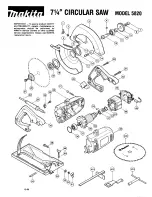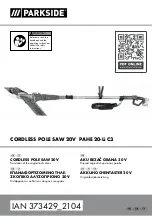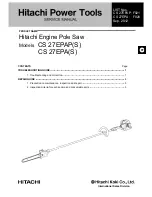
– 24 –
AVOID KICKBACK by pushing forward on the
section of the workpiece that passes between the
blade and the fence. Never perform any freehand
operations.
Fig. PP
NOTE
: Always use a push stick. When width of the rip is
narrower than 2 in. (50.8 mm) the push stick cannot be
used because the guard will interfere. Therefore, use
the auxiliary fence so the push stick can be used as
shown on page 32.
7. Keep your thumbs off the table top. When both of
your thumbs touch the front edge of the table (2),
finish the cut with a push stick. To make an additional
push stick, use the pattern on page 32.
8. The push stick (3) should always be used.
9. Continue pushing the workpiece with the push stick
until it passes through the blade guard and clears the
rear of the table.
10.Never pull the piece back when the blade is turning.
Turn the switch OFF. When the blade completely
stops, you can then remove the workpiece.
BEVEL RIPPING
This cut is the same as ripping except the blade bevel
angle is set to an angle other than 0°.
SETTING BEVEL ANGLE (FIG. QQ)
1. To set the bevel angle, loosen the blade bevel
lock handle (1) which is the handle on the blade
elevation handwheel (2), and then turn the blade
tilting handwheel (3) counterclockwise to bevel the
blade to the left. Turn the blade tilting handwheel (3)
clockwise to return the blade to the vertical position.
2. To lock the blade at the required bevel setting, turn
the blade bevel lock handle (1) counterclockwise.
Always release the blade bevel lock handle prior to
changing the bevel setting and relock the handle
after the required bevel angle is set.
3. If the blade bevel lock handle (1) interferes with the
blade tilting handwheel (3) while it is being tightened
the handle can be pulled forward to allow it to be
CUTTING OPERATIONS
There are two basic types of cuts: ripping and
crosscutting. Ripping is cutting along the length and the
grain of the workpiece. Crosscutting is cutting either
across the width or across the grain of the workpiece.
Neither ripping nor crosscutting may be done safely
freehand. Ripping requires the use of the rip fence, and
crosscutting requires the miter gauge.
Before using the saw each and every time, check
the following:
1. The blade is tightened to the arbor.
2. The bevel angle lock knob is tight.
3. If ripping, the fence is locked into position and is
parallel to the miter gauge groove.
4. The blade guard is in place and working properly.
5. Safety glasses are being worn.
6. Make sure casters are released in the up position
and that all four legs are resting evenly on the floor.
The failure to adhere to these common safety rules, and
those printed in the front of this manual, can greatly
increase the likelihood of injury.
RIPPING (FIG. PP)
To prevent serious injury:
•
Never use a miter gauge when ripping.
•
Do not allow familiarity or frequent use of your
table saw to cause careless mistakes. Remember
that even a careless fraction of a second is
enough to cause a severe injury.
•
Keep both hands away from the blade and clear
from the path of the blade.
•
The workpiece must have a straight edge against
the fence and must not be warped, twisted, or
bowed when ripping.
1. Remove the miter gauge, and hang it on the miter
guage storage loacted on the right side of stand.
2. Secure the rip fence to the table.
3. Raise the blade so it is about 1/8 in. (3.2 mm) higher
than the top of the workpiece.
4. Place the workpiece flat on the table and against the
fence. Keep the workpiece away from the blade.
5. Turn the saw ON and wait for the blade to come to
full speed.
6. Slowly feed the workpiece into the blade by pushing
forward only on the workpiece section (1) that will
pass between the blade and the fence.
WARNING
!
WARNING
!
WARNING
!
1
2
3















































